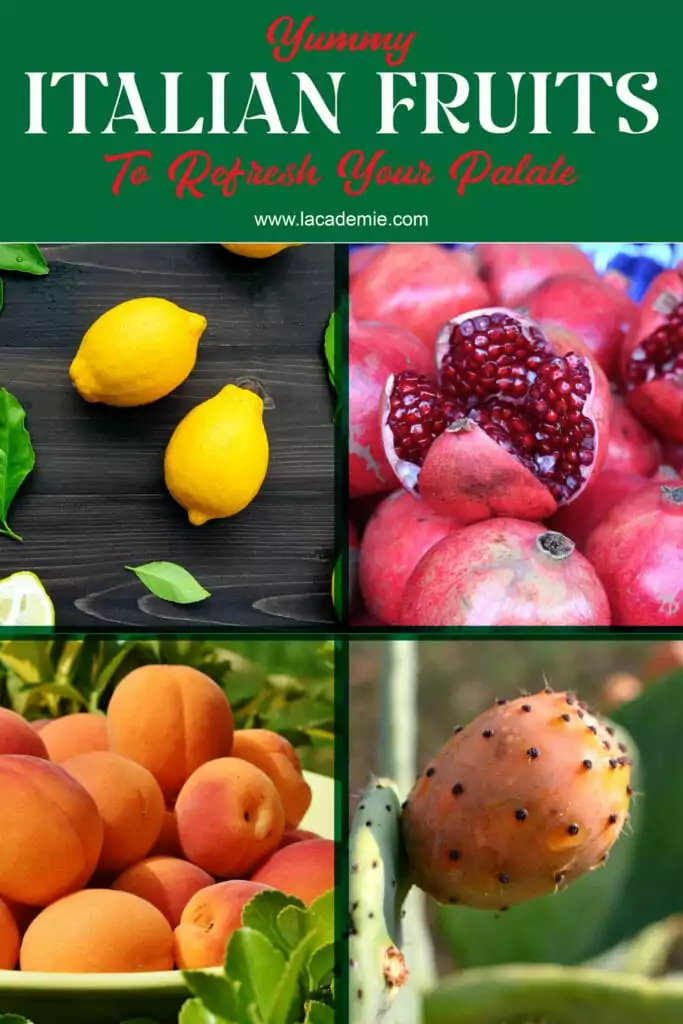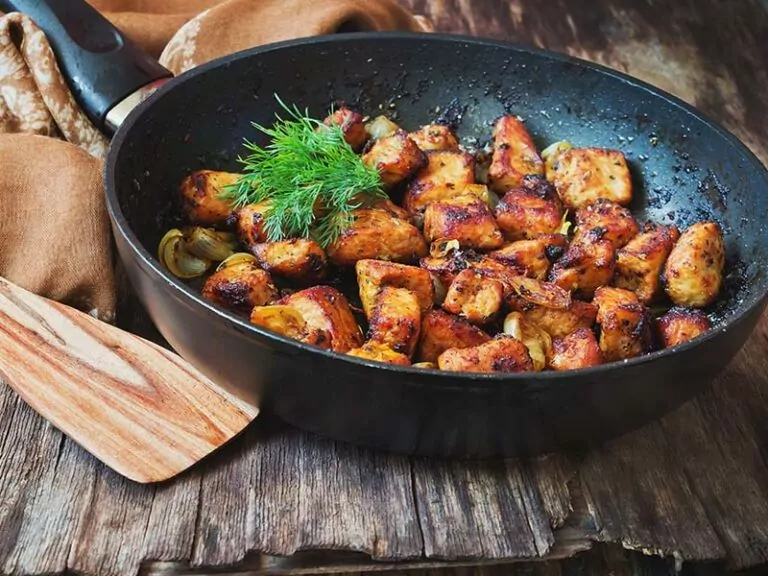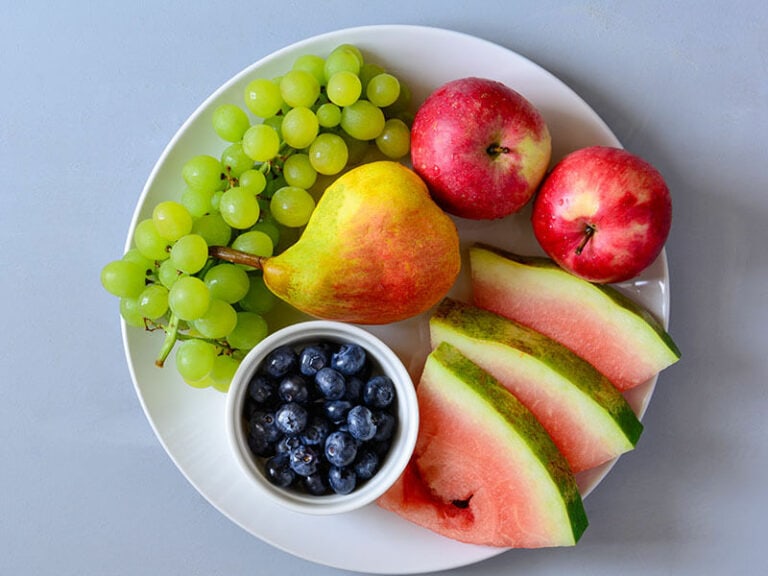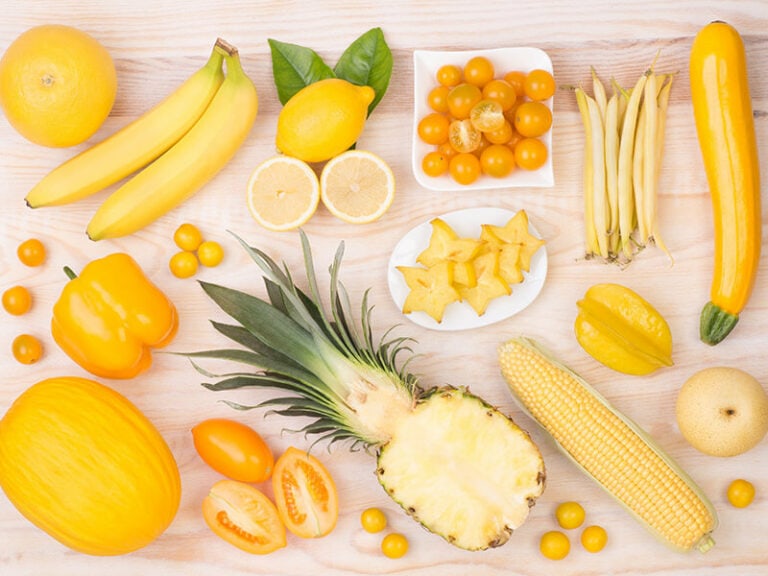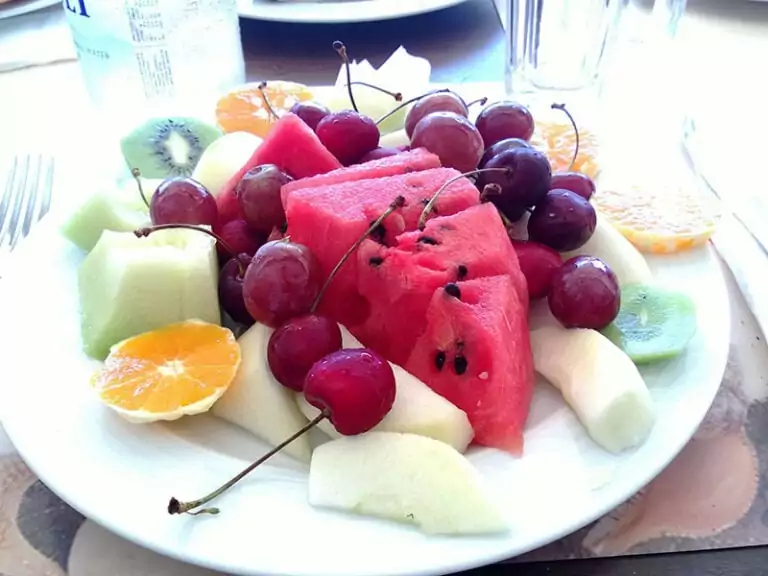How many Italian fruits do you know? Do you want to expand your knowledge with many exotic fruits? You are in the right place since this article contains everything you are looking for. Please step into the world of delicious and well-known Italian fruits.
Besides delicious Italian recipes, you can try the excellent taste of unique and yummy fruits when coming to this country. It is an exciting experience you should try on your upcoming trip. The fruits are excellent choices for desserts.
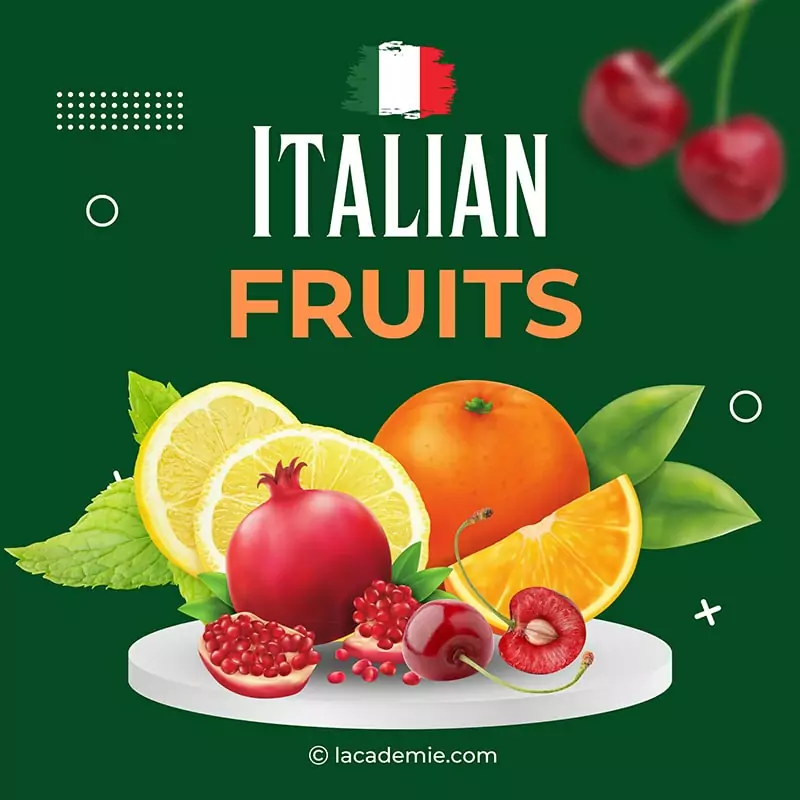
3 Excellent Italian Citrus Fruits To Change Your Palate
This section is for citrus fruit lovers. If you are one of them, you should stop now. The distinctive and excellent flavor of Italian citrus fruits will make you fall in love with them right now.
1. Lemons – Il Limone
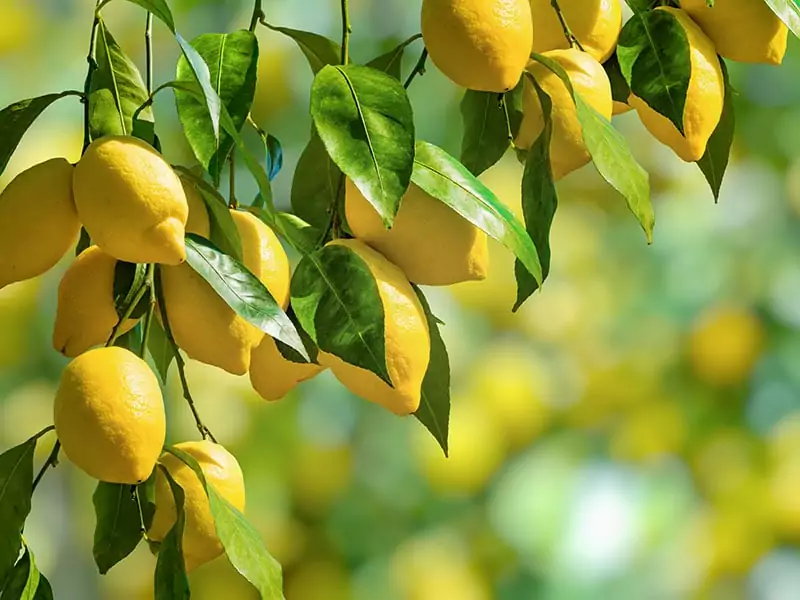
Lemons play a critical role in cleaning and cuisine in Italy. Also, people use it to give as presents or exchange for food during the harvests. Initially, lemons were a global fruit when appearing in many regions. It is native to Northern Myanmar, Northeast India, and China.
It appeared in Southern Italy in Ancient Rome time. But until the 15th century, Italians started cultivating this fruit in Genoa. There are 3 different types of lemons, such as Amalfi Lemons, Etna Lemons, and Sicilian Lemons.
Because lemons belong to the citrus fruit group, they will have 3 sections, including the rind, juicy segments, and tiny seeds. When you come to Salerno province on the Amalfi coast, you will have a chance to try Amalfi Lemons.
Usually, its skin is yellow or green. Especially, its flavor is similar to the familiar orange with a sweet and delicate taste. Italians often eat it fresh or mix it with salt and vinegar to make a zesty summer dessert.
Etna Lemons are the famous fruit on the Etna coast. You can find it in oval, elliptical, or spherical shapes with yellow or light green hues. It has 2 types, including Monachello and Femminello. This type is often available in spring, summer, or winter in Italy.
Sicilian Lemons is the most famous lemon in Italy. Sicily provides about 90 percent of lemons for Italy and Europe. Yellow is the dominant color of it. The milder taste and oilier rind are suitable for making desserts and cocktails.
Nutrients: It is time to add vitamin C, potassium, and vitamin B6 to your body.
Season: The peak season starts from the end of March to October in Italy.
How to eat: The standard way is to peel its rind and separate segments to consume. Furthermore, you can cut it into small slices and eat the flesh from the skin. Italians often cut it into 2 halves and squeeze to get juice.
Take a trip to Italy to explore an Almafi lemons garden and try their taste.
2. Ribera Oranges – Arancia Di Ribera
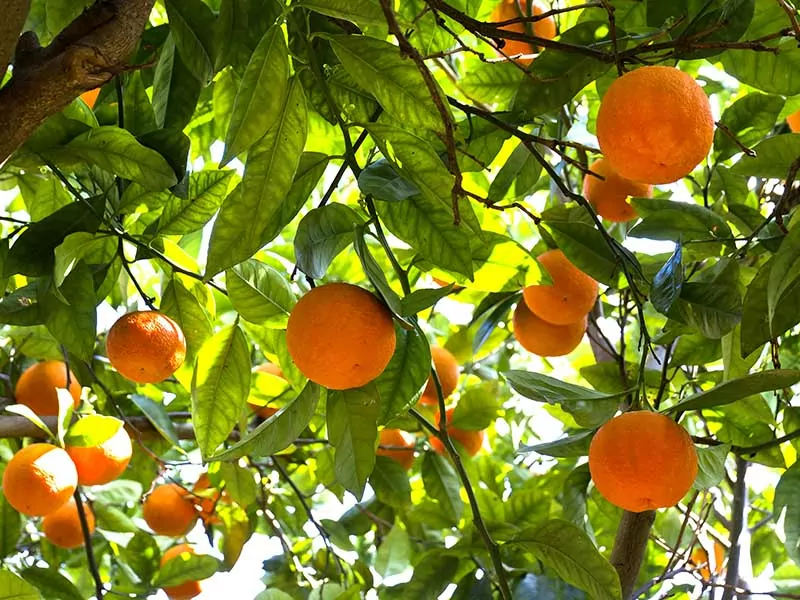
When speaking of delicious Italian drinks, it is impossible not to mention Ribera orange juice. Orange is native to Southern China, Myanmar, and Northeast India. It appeared in Europe when Moors brought it to the Iberian Peninsula.
It was introduced in Sicily of Italy in the 9th century during the Emirate of Sicily period. Until the end of the 15th century, people knew it widely. Ribera oranges are cultivated commonly on the Magazzolo and Verdura Platani rivers.
Typically, Ribera oranges look prominent in the yellow or pale orange skin. It has a distinctive round shape. After peeling the rind, there are about 8 to 10 succulent and yellow segments inside. It has 3 main types: Navelina, Brasiliano, and Washington Navel.
Most Ribera oranges have sweet flesh, and they usually appear in traditional Sicilian meals, especially in seafood recipes like Cod Carpaccio or scallops. Furthermore, Italians also use these fresh oranges for desserts or juice.
Nutrients: Calories, fiber, protein, vitamin A, C, and calcium.
Season: The primary season runs from November to May in Italy.
How to eat: Peel the entire skin and consume its segments. In addition, you can cut it into slices and eat the flesh from the rind. It is possible to squeeze juice after cutting it into 2 halves.
3. Sicilian Red Oranges – Arancia Rossa Di Sicilia
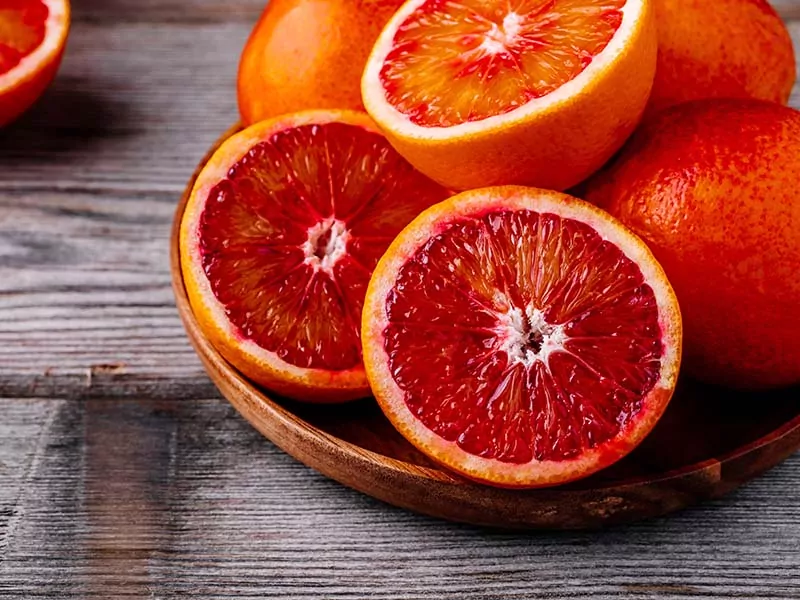
It is essential to mention Sicilian Red Oranges in this article since it is an iconic fruit of Italy. People often call it “Blood Oranges” as it has blood-colored flesh. The fertile volcanic soil in Mount Etna is a reason leading to its characteristic color.
It is a hybrid citrus fruit between tangerine and pomelo. Usually, you can simply realize it, thanks to the dark rind. In particular, it is hard to peel its skin as it is tougher than other common Oranges.
Unlike the sweetness of other types of Orange, Blood Oranges are sour and bitter. You can think of the flavor of raspberries with a few citrus tastes. Italians love to make jams, bitters, desserts, or cocktails from it. Occasionally, it is used for garnish to bring classic notes.
Blood Oranges have 3 dominant types such as Tarocco (Italy), Sanguinello (Spain), and Moro (newest sort). The blood-like color of Tarocco will be lighter than the 2 other ones. To reduce the fraudulent sale and production, the Italian government issues restrictions.
Nutrients: High in calories, carbs, protein, potassium, vitamin C, and folate.
Season: It is often ripe from mid-December to mid-June in Italy.
How to eat: The ways to consume it are similar to the methods you apply for Lemons.
It is time to take a closer look at Blood oranges and explore some essential information.
3 Outstanding Italian Fruits Of Drupe Category
When speaking of drupes, you will think of the fruits that contain only one seed in the middle. You can refer to these Italian fruits belonging to the drupe category to add to your desserts menu.
4. Amarena Cherries – Amarena Ciliegio
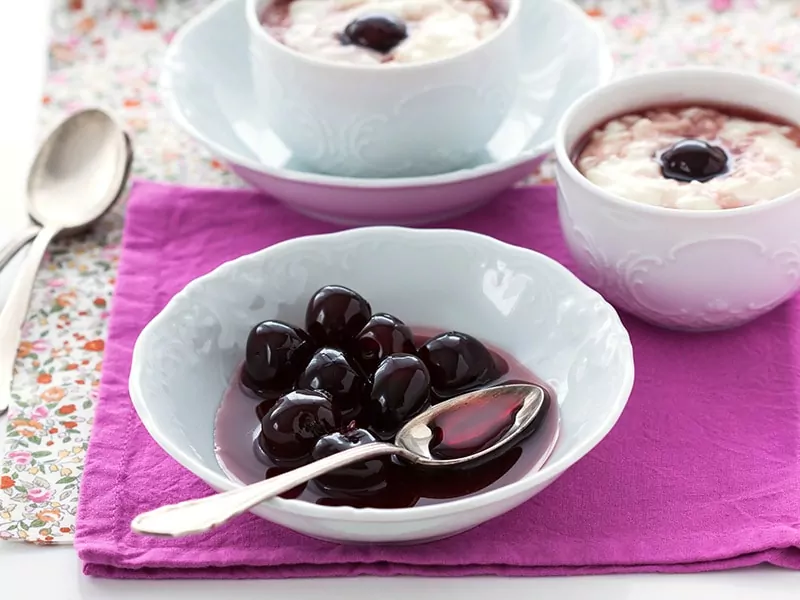
If you are a fan of cherry, you should not miss Amarena cherry. It is a famous Italian dessert loved by natives and tourists. It is native to Modena and Bologna cities of Italy. Gennaro Fabbri produced it first in the 20 century.
His wife mixed Amarena cherries with sugar to create an excellent syrup. She poured syrup into the ceramic jars and sold it as a commercial product. And he established a company to produce items related to cherries, such as pastries and beverages, in 1905.
Unlike South American cherries, Italian cherries have a dark color and juicy, firm flesh. It will bring acidic flavor to Italian foods. Italians often eat it fresh or mix it in cocktails and desserts. It is perfect for tasting Amarena cherries with Greek yogurt and chocolate.
Nutrients: Rich in carbs, vitamin C, and calories.
Season: It is available in July in Italy.
How to eat: You just need to put the whole fruit in your mouth to enjoy after rinsing.
5. Italian Peaches – La Pesca
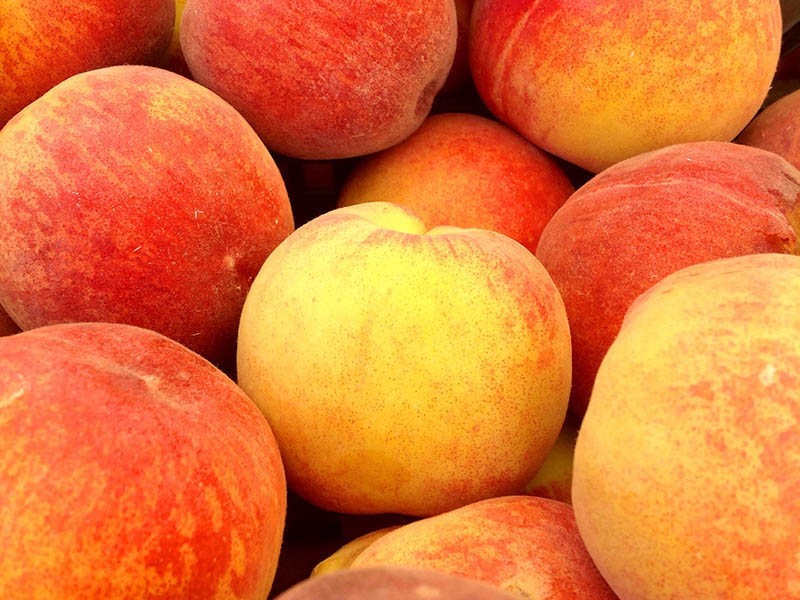
Italy was the second Peach producer globally in 2018 with 1.09 million tonnes. Besides Italy, it is a common element in many excellent Chinese foods since this place is the homeland of Peaches.
The thin velvet skin of Peach will help you acknowledge it easily. In addition, the deep pink or pale red colors will make this fruit look appealing. It has whitish or yellowish flesh with a seed in the middle. The stone can be broken depending on the variety.
It is perfect for enjoying the attractive sweetness, a slight tanginess, juiciness, and excellent fragrance of its flesh. Thanks to the outstanding flavor, Italians consider Peach an incredible dessert after each meal or mix it with goat cheese or balsamic vinegar.
There are 3 different types of Peaches in Italy, including Polpa Gialla (yellow flesh), Polpa Bianca (white meat), and Nettarina A Polpa Gialla (yellow flesh nectarine). This fruit is commonly planted around Lake Garda in Italy.
Nutrients: Rich in calories, fat, carbs, fiber, protein, vitamin A and C.
Season: This season extends from May to June in Southern Italy and from June to September in Romagna.
How to eat: You just need to peel the entire skin and eat around the stone. In addition, it is possible to cut it into 2 parts and remove the seed before consuming it.
6. Apricot – I’Albicocca
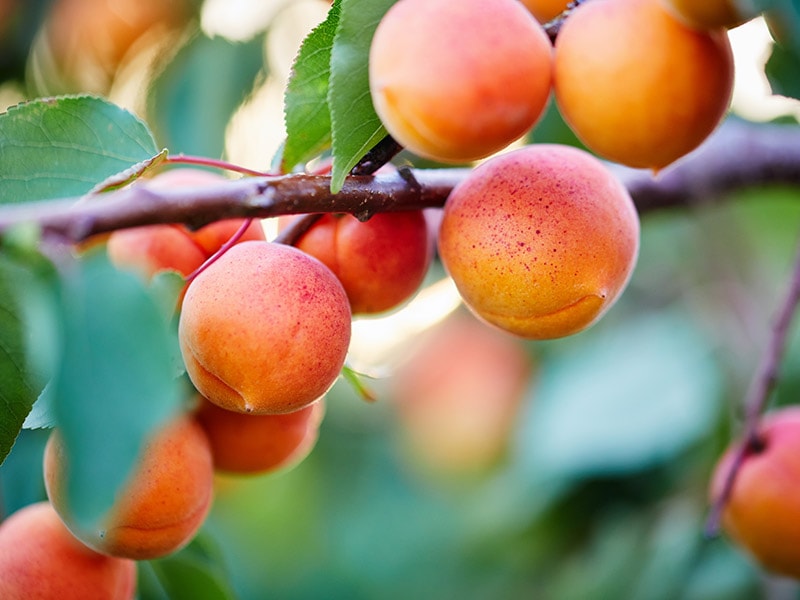
It is a pity not to try Apricot when traveling to Italy. This fruit appeared commonly in Armenia in Ancient times. It was cultivated in Italy during the Ancient Romans, and it came from Greece. Its cultivation took place on the fertile slopes of Vesuvius.
Nowadays, it is simple to find it in the Campania area of South Italy. There are about 2000 hectares of land used to produce apricots in Italy. Therefore, this country has become the leading Apricot producer for Europe.
It is a drupe fruit with many similarities to a small Peach. It is covered by yellow or orange smooth skin. The juiciness is the prominent feature of its flesh. Besides, the characteristic sweetness and tartness will attract you right away.
It contains a single seed (stone). It has a smooth and grainy consistency with 3 ridges along the sides. Italians often consume it as a fruit dessert or make jams, fruit candies, syrup, and other desserts.
Nutrients: Rich in vitamin A, C, E, potassium, lutein, beta-carotene, pantothenic acid, and zeaxanthin.
Season: It season runs from late June to August in Italy.
How to eat: The first way is to peel its skin and consume the flesh around the stone. The second choice is to cut it into 2 parts and remove its seed before tasting.
Follow these directions to make an excellent Jam Tart from Apricot.
3 Delicious Italian Pome Fruits For Your Desserts
There are many mouthwatering fruits of the pome category you must try in Italy, such as Apples, Pear, or Quince. Let’s explore some crucial things about them before tasting.
7. Sicilian Prickly Pear – Ficodindia
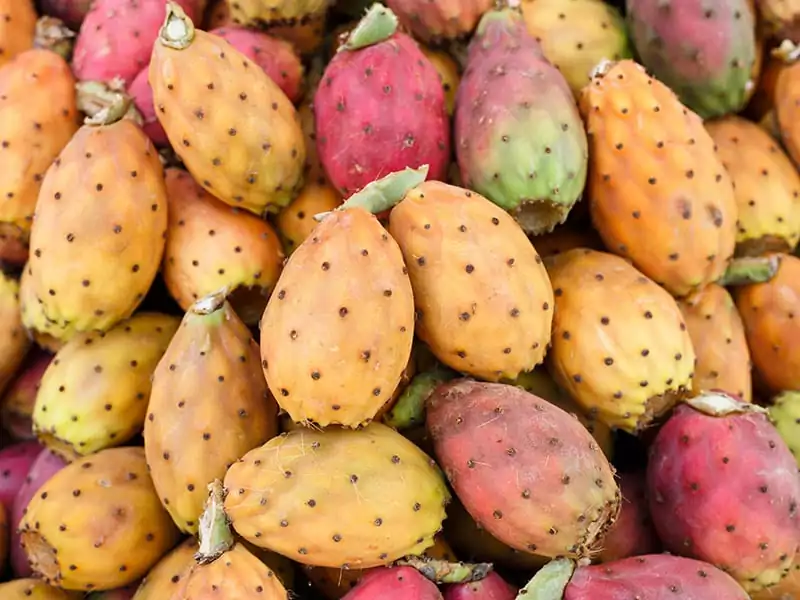
Also known as Prickly Pear or Opuntia, Pear Cactus is a member of the Cactaceae family. People usually call it “Tuna fruit”. This fruit is common in the Sicilian province of Catania, especially in the Mount Etna Regional Park. It thrives well in volcanic soil conditions.
This unique fruit has white, reddish-purple, or yellow colors. And, you should be careful with sharp protruding spines around its skin. The softness and juiciness of inner dark red flesh will captivate you immediately, and it consists of countless tiny edible seeds.
Besides the delicate fragrance, it has a sweet and rich flavor. It is easy to think of the taste of lemons and watermelons while consuming it. It is perfect for satisfying your thirst with this fruit. You can find it in jams, sauces, and roasted or boiled foods.
Nutrients: Rich in carbs, fat, calories, vitamin C, magnesium, potassium, calcium, and phosphorus.
Season: Its season lasts from September to November in Italy.
How to eat: Let’s start peeling its rind and consume its juicy flesh, or cut it into 2 halves and get the flesh out by a spoon.
8. Melograno Apples/ Pomegranate – Melagrana
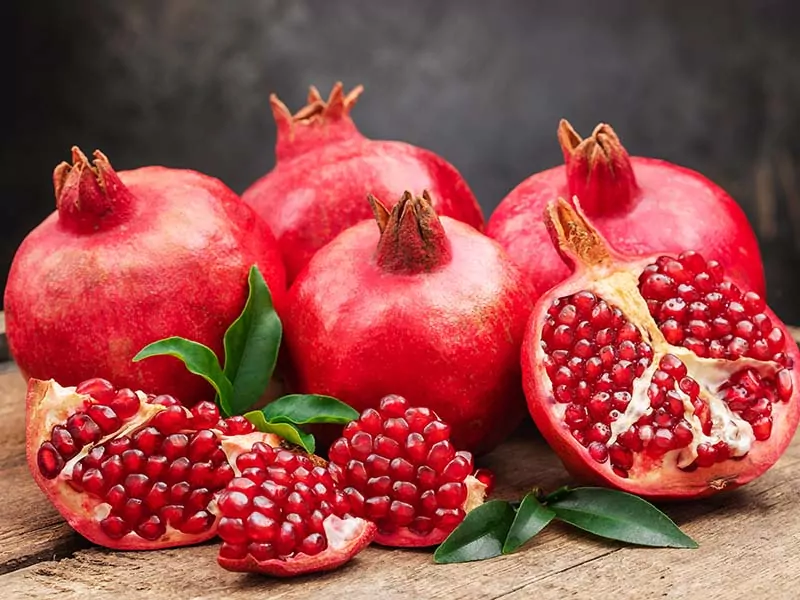
Melograno Apples is another name that Italians usually use to call Pomegranates. If you love Italian side dishes like salad, it is a shortcoming when you ignore Melograno Apple salad. Moreover, you can find it with cocktails and Feta or Reggiano cheeses.
This fantastic fruit is native to the Mediterranean region. This fruit is common from March to May in the Southern Hemisphere and from October to February in the North Hemisphere. In Italy, it is available at the end of Autumn and mid-Winter.
Typically, Melograno Apples often appear in the red-purple husk. You can find a rough pericarp outside and a spongy mesocarp in its husk. There are numerous edible red or white seeds inside this fruit.
The sweetness and slight tartness of its juicy flesh will refresh your palate immediately. Italians often consume it as a fruit dessert or make juice, smoothies, desserts, and cocktails from it. It is a healthy fruit for your heart with many good nutrients.
Nutrients: High in calories, protein, carbs, fat, fiber, calcium, and iron.
Season: It is available in November in Italy.
How to eat: You should start cutting it into 2 halves and use a spoon to scoop out its juicy and edible seeds.
9. Quince – Il Cotogno
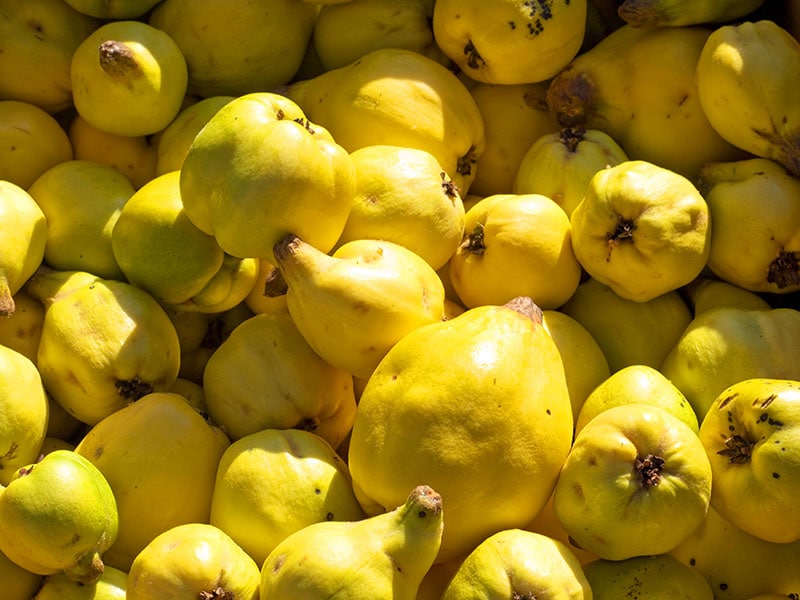
Quince is an indispensable name in this great list. It belongs to the Rosaceae family and is a pome fruit with an eye-catching golden-yellow. You can imagine the Pear when looking at its appearance. It originates in the Hyrcanian forest of the Caspian Sea.
In Italy, Sicily is the principal place that produces the most Quince. This excellent flavor is suitable to mix in many Italian recipes. It has a gray-white hair layer covered around it. It is time to immerse yourself in its juiciness and intensely perfumed flesh.
The acidity is the primary flavor of Quince. Alternatively, it is possible to find a bit of astringent taste from this unique fruit. The appealing flavor is a combination of Pear, citrus, and Apples.
Italians often cook Quince with sugar and lemon juice to make fantastic Quince jelly (Cotognata). Furthermore, it is a standard option on many special occasions in Italy.
Nutrients: It includes calories, carbs, fiber, vitamin C, B6, and thiamine.
Season: It is easy to buy Quince from September to October in Italy.
How to eat: It is simple to consume it by peeling and consuming its flesh, and remember to remove its seed.
Follow these directions to consume and preserve Quince.
Diversify Your Choices With 3 Amazing Italian Berries
When referring to excellent Italian fruits, it is a pity not to mention berries. They are critical fruits of the cuisine of this nation. It is time to discover them.
10. White Figs – Fico Bianco Del Cilento
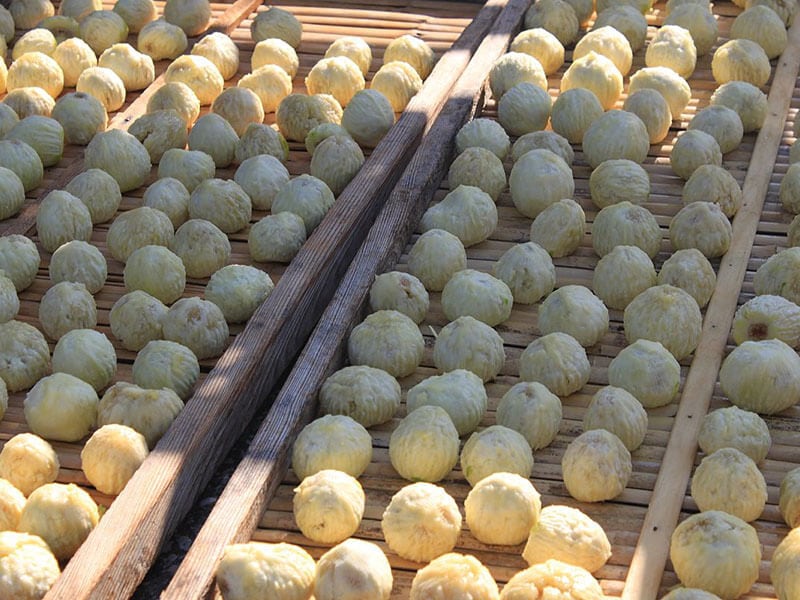
White Fig is a luxury food in Italy. Initially, Fig originated in Western Asia and the Mediterranean in ancient times. Now, its cultivation happens in many parts worldwide. White Fib is a typical fruit in the Campania province of Salerno.
Field workers usually consume it as daily food. It has a high price in Italy and Europe. The best time to consume White Figs is from Spring to Summer because they have enchanting sweetness and grainy texture.
This delicious fruit has thin skin with beige, yellow, or pale green shades. You will fall in love with the tenderness and chewiness of its flesh. Moreover, the numerous edible seeds will bring crunchiness while consuming.
Typically, it is straightforward to come across dried White Figs in many gourmet restaurants and boutique cafes in Italy. In addition, Italians often stuff it with nuts or drizzle it with lemon juice for snacks. To purchase cheap White Figs, you should go to vendors at roadside or markets.
Nutrients: A source of calories, carbs, fiber, copper, magnesium, and potassium.
Season: July to September is the best time to pick White Figs in Italy.
How to eat: You can consume Fig after rinsing this fruit.
11. Kiwi – Il Kiwi
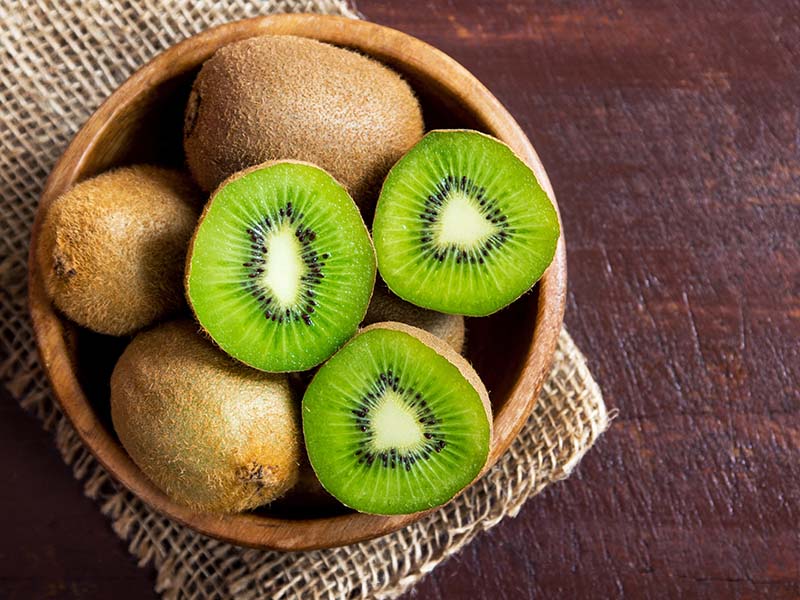
Kiwi is another fruit I want to introduce in this article. This delicious fruit is native to Eastern and Central China. The first records about it existed in the 12th century during the Song Dynasty. Italians knew it widely in the 1930s, and Italy had Kiwifruit orchards in the 1960s.
Typically, this fruit exists in the oval form, and it has the same size as an egg. It looks unique with a thin and edible light brown rind. You will love the tenderness and sweetness of its light green or golden flesh. When you eat it skin, you can feel a bit of tartness.
There are numerous black and tiny seeds, and it is safe to consume them. Italy is one of the primary Kiwi producers globally, with about 562188 tonnes in 2018. It ranks second in the world after China.
You can use Kiwi for many purposes. It is great to eat it raw or get juice for drinks. Moreover, you can mix it in baked goods, meat dishes, or garnish.
Nutrients: It is a source of carbs, fiber, vitamin C, calcium, magnesium, phosphorus, and potassium.
Season: It is common from October to March in this country.
How to eat: The standard way is to cut it into 2 halves and use a spoon to take the flesh out. Or, it is possible to peel its skin and cut it into slices for dessert.
Explore 7 exciting facts you need to know about Kiwi fruit.
12. Grapes – I’ Uva
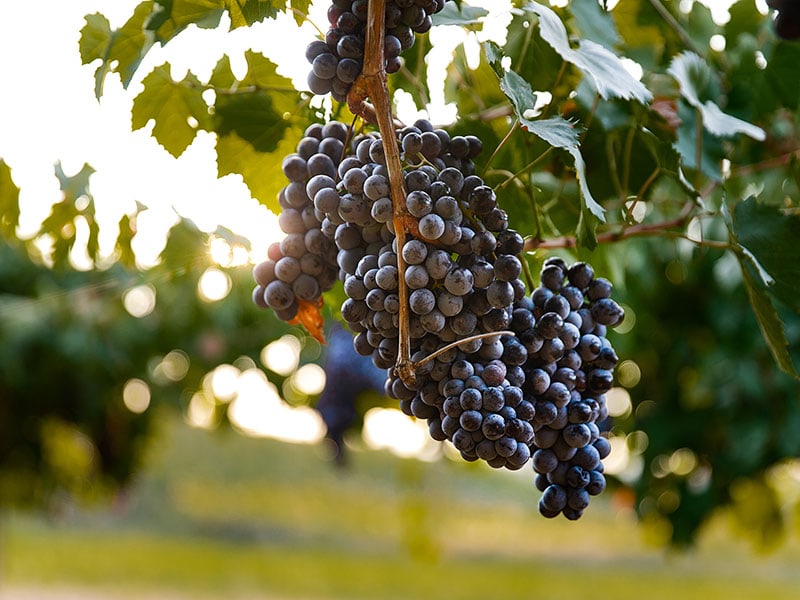
When referring to Italian fruits, it is impossible not to mention Grapes. It is a vine plant and plays an essential role in making grape wine in Italy. It originated in the Middle East 6000 to 8000 years ago. It appeared in Italy during Ancient Roman times.
It is diverse in shades with black, dark blue, green, orange, pink, crimson, or yellow. Its juicy and jelly-like flesh will captivate you immediately. It is easy to find the exquisite sweet taste and a bit of acidity from these fantastic Grapes.
There are many different types of Grapes in Italy, but the white table grape is the most common variety in Italy. It was a result of crossing Muscat Hamburg and Bican grapes in 1911. It is the main ingredient for making Pisco Punch (wine).
Besides Spain and France, Italy is one of the top three producer grapes for making wine worldwide. Moreover, Grapes are a delicious fruit dessert you should try in Italy. Italians often add it to many excellent dishes or drinks.
Nutrients: Carbs, negligible fat, calories, vitamin K, and protein.
Season: September to October is the best time for harvesting Grapes in Italy.
How to eat: The best way to consume grapes is to eat them after washing and remove seeds while eating. In addition, you can remove its skin before eating.
Do You Love These Fruits?
Are you satisfied with the list I have provided in this exciting post? Do not forget to taste them if you have the chance to come to Italy. I guarantee their flavor will stimulate your taste buds immediately.
You will help improve the quality of the tour of many people by sharing this valuable article. Furthermore, I am looking forward to obtaining your thoughts about the quality of the post. I will try to bring many high-quality articles to you in the future.
